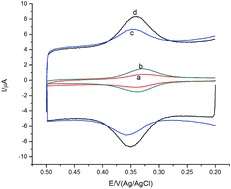Electrochemical determination of luteolin in Chrysanthemum using multi-walled carbon nanotubes–ionic liquid composite electrode
Abstract
A simple and sensitive multi-walled carbon nanotubes (MWCNTs)–ionic liquid (1-butyl-3-methylimidazolium hexafluorophosphate, BMIMPF6, IL) composite modified glassy carbon electrode (GCE) was successfully developed for the electrochemical determination of trace-levels of luteolin. The prepared composites were characterized by scanning electron microscopy (SEM). Compared with the bare GCE, the BMIMPF6/GCE and MWCNTs/GCE, MWCNTs–BMIMPF6/GCE exhibited a higher electrocatalytic ability toward the oxidation of luteolin due to the synergic effects of the good electrical properties and large surface-to-volume ratio of the MWCNTs together with the good conductivity and wide potential windows of the IL. A series of experimental parameters including the pH of the supporting electrolyte and accumulation time were optimised. The electrochemical sensor can be applied to the quantification of luteolin with a linear range covering 5 × 10−9–1 × 10−6 mol·L−1 (with a correlation coefficient of 0.9969) and the limit detection is 5 × 10−10 mol L−1 (S/N = 3). Moreover, the method was successfully applied for the determination of luteolin in Chrysanthemum as a real sample with satisfying results.


 Please wait while we load your content...
Please wait while we load your content...